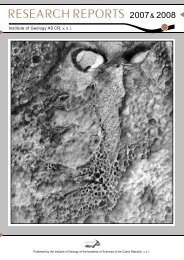triradiate locomotion Triadobatrachus evidenced segmentation
Get PDF (915K) - Wiley Online Library
Get PDF (915K) - Wiley Online Library
Create successful ePaper yourself
Turn your PDF publications into a flip-book with our unique Google optimized e-Paper software.
20 Development of the pelvic skeleton in frogs, H. RoCková and Z. RoCek<br />
both postsacral (i.e. the 10th and 11th) vertebrae<br />
(Fig. 1J), but later (at stage 57) it expands anteriorly, so<br />
that it reaches beneath the posterior part of the sacral<br />
vertebra (Fig. 1K). Its posterior expansion is only moderately<br />
delayed, so that in stage 58 it reaches beyond<br />
the level of the most posterior extent of the fused neural<br />
arches (Fig. 1L). Its posterior end is slightly declined<br />
from the notochord and is oval, instead of semicircular,<br />
in cross-section. Because constriction of the notochord<br />
proceeds in an anterior–posterior direction, owing to<br />
developing vertebral centra, the anterior end of the<br />
hypochord approaches the bases of the sacral neural<br />
arches in stage 58, whereas it still occupies its original<br />
position posteriorly (Fig. 1L). The ventral extended<br />
parts of the postsacral neural arches fuse with each<br />
other on either side in stage 57, thus forming a pair of<br />
cartilaginous strips adjacent dorsolaterally to the notochordal<br />
sheaths (Fig. 1M,P). From these strips the neural<br />
arches of two, occasionally three, postsacral<br />
vertebrae protrude dorsally; in stage 59 (Fig. 1M), the<br />
neural arches of the 1st postsacral vertebra do not fuse<br />
with one another, whereas the sacral vertebra is<br />
already complete dorsally. Dorsal ends of the postsacral<br />
neural arches on both sides expand anteriorly and posteriorly<br />
(Fig. 1L), which ultimately results in formation<br />
of permanent (anteriorly) or temporary (posteriorly)<br />
foramina for spinal nerves. The thickened posterior<br />
end of the hypochord approaches the fused neural<br />
arches, in accordance with reduction of the notochord.<br />
Simultaneously with the development of the postsacral<br />
vertebral column, the hind limb develops<br />
towards its distal end. The tibia and fibula appear<br />
shortly after the femur. Only when the astragalus and<br />
calcaneus are formed, and when the neural arches of<br />
the 11th vertebra and of the hypochord may be recognized<br />
(at stage 54), do the earliest rudiments of the pelvis<br />
appear. As the early development of the pelvis is<br />
very fast and because the number of investigated specimens<br />
in these crucial developmental stages was limited,<br />
we were not able to decide which pelvic element<br />
appeared as the very first. In Bombina, which is closely<br />
related to Discoglossus, although affected by heterochrony<br />
(retarded skeletogeny), the ilium appears first<br />
(see below). By the end of stage 54 the complete vertical<br />
pelvic rod is present, and the ilium begins to expand<br />
dorsally into a shaft (ala ossis ilii) in the direction of the<br />
sacral vertebra. Moderate rotation of the pelvis starts<br />
as soon as stage 55 (Fig. 1J), still before the ilia reach<br />
the level of the sacral neural arches at stages 56–57<br />
(Fig. 1I,K,L). The iliac shafts retain their nearly vertical<br />
position until stage 58 (Fig. 1L). The rotation accelerates<br />
at stage 59 (Fig. 1N), but the ultimate position of<br />
the pelvis is reached only in fully grown adults, whereas<br />
at the end of metamorphosis (stage 66) the angle of<br />
the iliac shafts is still about 45° (Fig. 1O). Both sacral<br />
diapophyses develop independently on the neural<br />
arches (the line of contact between both cartilages my<br />
be still discerned by the end of metamorphosis; see<br />
Fig. 1R). Both halves of the pelvic girdle, which are<br />
associated with rudiments of each extremity, begin to<br />
develop separately from one another, but come into<br />
contact with each other as early as stage 57, although<br />
the line of coalescence may be discernible until the end<br />
of metamorphosis. They establish contact first in the<br />
posterior part, by the ischia, then by the pubes. The<br />
praepubes appear in stages 56–57 (Fig. 1L) as a symmetrical<br />
pair of cartilages protruding anteriorly from<br />
the pubes (Fig. 1L,N–P). Both pubes and praepubes<br />
remain cartilaginous in adults; the definitive morphology<br />
of the ilia develops from stage 59, when the dorsal<br />
margin of the iliac shaft expands as a thin crista made<br />
first of perichondrium (Fig. 1P) that later ossifies. The<br />
ultimate morphology of the ilia is undoubtedly formed<br />
in association with large muscles. For instance, the dorsal<br />
crista on the iliac shaft and the tuber superius,<br />
which develop from the perichondrium, are areas of<br />
attachment for the iliacus externus and gluteus maximus<br />
muscles, respectively (Fig. 1P,Q).<br />
The ilio-sacral articulation develops at about stage 60<br />
when the dorsal portion of the iliac shaft comes into<br />
contact with the lower surface of the developing sacral<br />
diapophysis (Fig. 1R). The ilia may not reach anteriorly<br />
far beyond the sacral diapophyses, which suggests that<br />
they may slide forwards and backwards over the sacral<br />
diapophyses to a limited extent (Fig. 1D,F,G).<br />
Simultaneously with the development and positional<br />
changes of the pelvis, the neural arches of further vertebrae<br />
develop (12th and sometimes also 13th; rudimentary<br />
Fig. 1 Discoglossus pictus. Note early fusion of both halves of the pelvis (B) and presence of the praepubis (L,P). (A–H) Stage 52;<br />
(B–J) stage 55; (C, E, I, K) stage 57; (D, F, L1) stage 58; (G) adult. (A–D, E, G, M in dorsal view; F, ventral view; H–L, N, O in left<br />
lateral view). (M) 3D model of pelvis and of some pelvic muscles at stage 59. (N) 3D model of pelvis at stage 59. (O) 3D model of<br />
pelvis at stage 66. (P, Q) Frontal sections at the levels indicated in M and N; m. rectus abdominis attached to the praepubis is<br />
marked by an arrow. (R) Frontal section at the level indicated in O. Scale bars in A–D, 5 mm.<br />
© Anatomical Society of Great Britain and Ireland 2005





